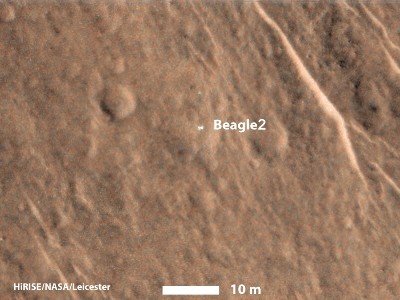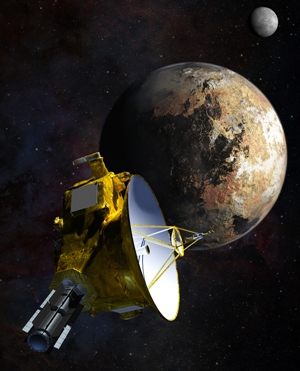
This annotated image from NASA's Mars Reconnaissance Orbiter shows a bright feature interpreted as UK's Beagle 2 Lander, which was never heard from after its expected Dec. 25, 2003, landing. The image was taken by the orbiter's HiRISE camera on Dec. 15, 2014.Image Credit: NASA/JPL-Caltech/Univ. of Arizona/University of Leicester
LONDON (PTI): A British-built space probe, thought lost on Mars since 2003, has been found on the surface of the Red Planet, ending the mystery of what happened to the mission more than a decade ago, the UK Space Agency has said.
Beagle-2 was released from its mother craft on December 19, 2003 and was due to land six days later. But nothing was heard from the lander after its scheduled touchdown.
Now, over a decade later, the lander has been identified in images taken by the high-resolution camera on NASA's Mars Reconnaissance Orbiter (MRO).
This find shows that the Entry, Descent and Landing (EDL) sequence for Beagle 2 worked and the lander did successfully touchdown on Mars on Christmas Day 2003, the agency said.
Beagle 2 hitched a ride to Mars on ESA's Mars Express mission and was a collaboration between industry and academia.
Images taken by the HiRISE camera on MRO have identified clear evidence for the lander and convincing evidence for key entry and descent components on the surface of Mars within the expected landing area of Isidis Planitia (an impact basin close to the equator).
Subsequent re-imaging and analysis by the Beagle 2 team, HiRISE team and NASA's Jet Propulsion Laboratory (JPL) has confirmed that the targets discovered, are of the correct size, shape, colour and dispersion (separation) to be Beagle 2, the agency said.
"This finding makes the case that Beagle 2 was more of a success than we previously knew and undoubtedly an important step in Europe's continuing exploration of Mars," said Dr David Parker, Chief Executive of the UK Space Agency.
The images, following analysis by members of the Beagle 2 team and NASA, show the Beagle 2 lander in what appears to be a partially deployed configuration, with what is thought to be the rear cover with its pilot/drogue chute (still attached) and main parachute close by.
Several interpretations of the image of the lander have been identified, consistent with the lander's size and shape.
The imaging data is however consistent with only a partial deployment following landing, the agency said.
This would explain why no signal or data was received from the lander - as full deployment of all solar panels was needed to expose the RF antenna which would transmit data and receive commands from Earth, it said.
"The images show that we came so close to achieving the goal of science on Mars. The highly complex entry, descent and landing sequence seems to have worked perfectly and only during the final phases of deployment did Beagle 2 unfortunately run into problems," said Professor Mark Sims of the University of Leicester who was an integral part of the Beagle 2 project.
Given the partial deployment (and covering of the RF antenna) it would not be possible to revive Beagle 2 and recover data from it, the agency said.
 Next Article
Next Article











The Indian Air Force, in its flight trials evaluation report submitted before the Defence Ministry l..
view articleAn insight into the Medium Multi-Role Combat Aircraft competition...
view articleSky enthusiasts can now spot the International Space Station (ISS) commanded by Indian-American astr..
view article